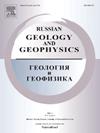Geochemistry and Mineralogy of Rare-Earth Elements in Ferruginous Deposits and Bottom Sediments of the Laptev Sea
IF 1
4区 地球科学
Q3 GEOSCIENCES, MULTIDISCIPLINARY
引用次数: 0
Abstract
––The geochemical and mineralogical aspects of the distribution of rare-earth elements (REE) in ferruginous deposits (FD) and bottom sediments of the southeastern Laptev Sea are analyzed. The FD are dominated by biomorphs developed after polychaete tubes. The REE patterns depend on the proportion of ore and non-ore substances. The ore substance is represented mainly by iron hydroxides (limonite). It is a product of suboxic diagenesis enhanced by bioturbation and determines the slight enrichment of FD in MREE and cerium deficiency (Cean = 0.94). The non-ore substance comes from terrigenous sediments and has an (alumino)silicate composition. It controls the scandium content and is the source of REE mineral grains, among which monazite-(Ce) prevails. The sediments demonstrate a common similarity in REE patterns to shales and suspended material transported to the Laptev Sea by the Lena River, with elevated LREE and MREE contents and the value of Ce anomaly almost equal to unity (Cean = 1.06). In the sediments, REE minerals occur mostly in the silt fraction (<63 μm in size). The high content of organic matter (Corg of up to 2.15%) of predominantly terrigenous origin (OMter of up to 85%) in the sediments explains the oxygen deficiency and weak diagenetic mineral formation with low accumulation of trace elements, including REE, in the FD. The total REE content in the FD is lower than that in the sediments (on average, 173 ppm against 206 ppm).拉普捷夫海含铁矿床和海底沉积物中稀土元素的地球化学和矿物学研究
——从地球化学和矿物学角度分析了拉普捷夫海东南部含铁矿床和海底沉积物中稀土元素的分布特征。FD以多毛体管后发育的生物形态为主。稀土元素模式取决于矿石和非矿石物质的比例。矿石物质主要为铁氢氧化物(褐铁矿)。它是生物扰动增强的缺氧成岩作用的产物,决定了在MREE和铈缺乏时FD的轻微富集(Cean = 0.94)。非矿石物质来自陆源沉积物,具有(铝)硅酸盐成分。它控制着钪的含量,是稀土矿物颗粒的来源,其中以独居石-(Ce)为主。沉积物的REE模式与由勒拿河输送到拉甫捷夫海的页岩和悬浮物具有共同的相似性,LREE和MREE含量升高,Ce异常值几乎等于1 (Cean = 1.06)。在沉积物中,稀土矿物主要赋存于粉砂层(粒度<63 μm)中。沉积物中以陆源为主的有机质(有机质含量高达2.15%)的高含量(有机质含量高达85%)解释了FD中缺氧和弱成岩矿物形成以及微量元素(包括REE)低富集的原因。FD中总REE含量低于沉积物中(平均173 ppm比206 ppm)。
本文章由计算机程序翻译,如有差异,请以英文原文为准。
求助全文
约1分钟内获得全文
求助全文
来源期刊

Russian Geology and Geophysics
地学-地球科学综合
CiteScore
2.00
自引率
18.20%
发文量
95
审稿时长
4-8 weeks
期刊介绍:
The journal publishes original reports of theoretical and methodological nature in the fields of geology, geophysics, and geochemistry, which contain data on composition and structure of the Earth''s crust and mantle, describes processes of formation and general regularities of commercial mineral occurrences, investigations on development and application of geological-geophysical methods for their revealing. As to works of regional nature, accelerated publication are available for original papers on a variety of problems of comparative geology taking into account specific character of Siberia, adjacent Asian countries and water areas. The journal will also publish reviews, critical articles, chronicle of the most important scientific events, and advertisements.
 求助内容:
求助内容: 应助结果提醒方式:
应助结果提醒方式:


